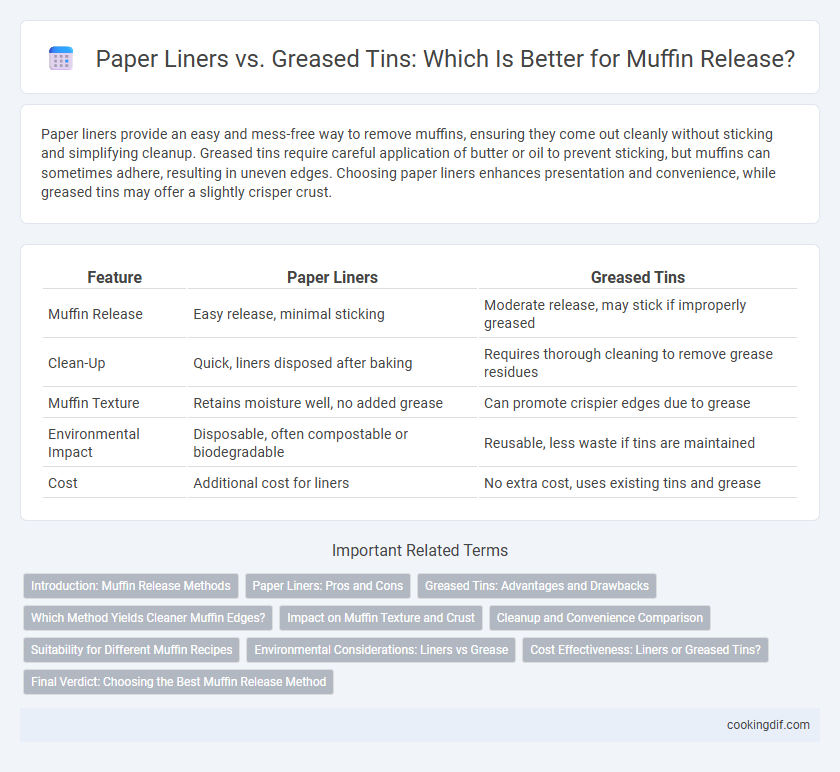Paper liners provide an easy and mess-free way to remove muffins, ensuring they come out cleanly without sticking and simplifying cleanup. Greased tins require careful application of butter or oil to prevent sticking, but muffins can sometimes adhere, resulting in uneven edges. Choosing paper liners enhances presentation and convenience, while greased tins may offer a slightly crisper crust.
Table of Comparison
| Feature | Paper Liners | Greased Tins |
|---|---|---|
| Muffin Release | Easy release, minimal sticking | Moderate release, may stick if improperly greased |
| Clean-Up | Quick, liners disposed after baking | Requires thorough cleaning to remove grease residues |
| Muffin Texture | Retains moisture well, no added grease | Can promote crispier edges due to grease |
| Environmental Impact | Disposable, often compostable or biodegradable | Reusable, less waste if tins are maintained |
| Cost | Additional cost for liners | No extra cost, uses existing tins and grease |
Introduction: Muffin Release Methods
Paper liners provide a convenient and hygienic muffin release method that prevents sticking and maintains muffin shape, ensuring easy removal and minimal cleanup. Greased tins require adequate lubrication with butter, oil, or baking spray to create a non-stick surface, which can enhance crust crispness but may alter muffin texture. Choosing between paper liners and greased tins depends on desired muffin aesthetics, ease of release, and cleanup preferences.
Paper Liners: Pros and Cons
Paper liners provide a convenient, mess-free way to bake muffins, preventing sticking and ensuring easy removal while maintaining the muffin's shape. They offer improved hygiene by minimizing direct contact with the baking tin, reducing cleanup time and preserving tin condition. However, paper liners may affect baking time and texture slightly, can detract from a crispy edge, and contribute to waste compared to greased tins.
Greased Tins: Advantages and Drawbacks
Greased tins offer superior heat conduction, resulting in evenly baked muffins with a crisp, golden crust. They reduce waste and cost since no liners are needed, making them environmentally friendly and economical. However, greased tins require thorough cleaning to prevent buildup and careful greasing to avoid muffin sticking, which can be time-consuming and inconsistent compared to paper liners.
Which Method Yields Cleaner Muffin Edges?
Paper liners provide cleaner muffin edges by preventing batter from directly contacting the tin, resulting in smooth, well-defined edges without sticking. Greased tins can produce muffins with slightly uneven or ragged edges due to batter caramelizing and adhering to the surface. For pristine presentation, paper liners are the preferred choice to achieve sharp, clean muffin edges.
Impact on Muffin Texture and Crust
Using paper liners for muffins preserves moisture, resulting in a softer texture and tender crumb by preventing direct contact with the tin. Greased tins create a slightly crispier crust due to the exposed batter edges caramelizing against the pan. The choice between liners and greased tins directly impacts muffin mouthfeel, balancing moistness against crustiness.
Cleanup and Convenience Comparison
Paper liners simplify cleanup by containing crumbs and reducing batter residue on muffin tins, making post-baking washing faster and easier. Greased tins often require more scrubbing due to stuck-on batter and oil, increasing cleaning time and effort. Using liners also prevents muffin sticking, enhancing convenience by eliminating the need to scrape tins and preserving their condition.
Suitability for Different Muffin Recipes
Paper liners provide a non-stick surface ideal for moist or fragile muffins like blueberry or bran, ensuring easy release without crumbling. Greased tins suit denser muffins such as banana or cornmeal, promoting crisp edges and even browning while requiring careful greasing to prevent sticking. Choosing between paper liners and greased tins depends on the muffin's texture and desired crust quality.
Environmental Considerations: Liners vs Grease
Paper liners reduce the environmental impact by minimizing the use of oils and enabling easier clean-up, which decreases water and detergent consumption. Greased tins, while reusable, often require frequent washing with harsh chemicals that can contribute to water pollution. Compostable paper liners offer a sustainable alternative, breaking down naturally and reducing landfill waste compared to synthetic greases.
Cost Effectiveness: Liners or Greased Tins?
Paper liners reduce cleanup time and prevent sticking, saving labor costs despite a higher upfront expense per baking session. Greased tins eliminate the need for liners and reduce waste, offering long-term savings but may increase cleanup time and risk muffin damage during release. Choosing between paper liners and greased tins depends on balancing the cost of disposable supplies against labor efficiency and product quality preservation.
Final Verdict: Choosing the Best Muffin Release Method
Paper liners provide a convenient, mess-free muffin release with less cleanup, preserving the muffin's shape and moisture, while greased tins offer a crispier crust and can be cost-effective for frequent baking. Muffin lovers seeking consistent texture and ease prioritize paper liners, especially in commercial baking settings where hygiene is crucial. For artisanal bakers aiming for a golden-brown exterior and environmental sustainability, greased tins remain the preferred method.
Paper liners vs Greased tins for muffin release Infographic

 cookingdif.com
cookingdif.com